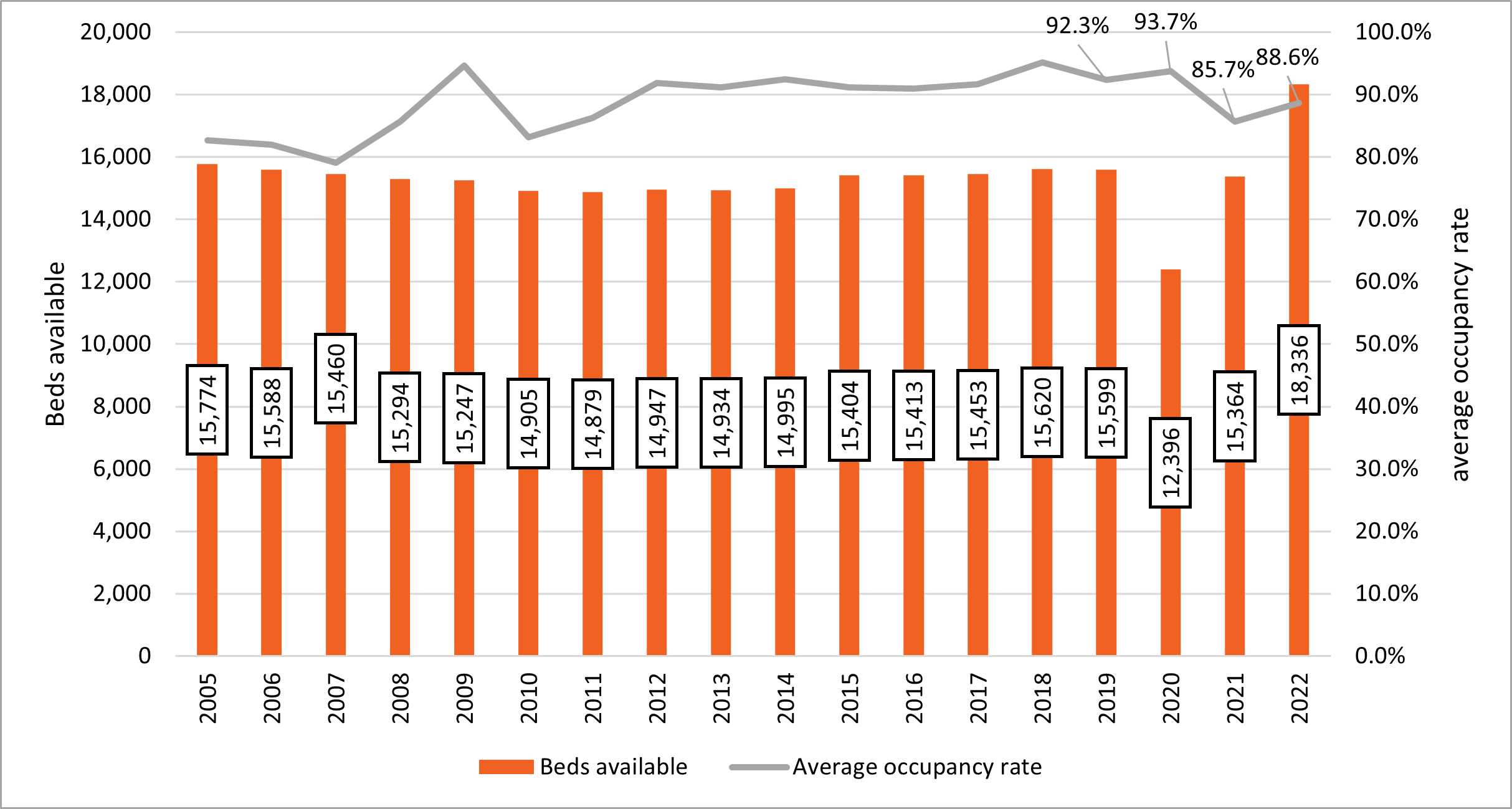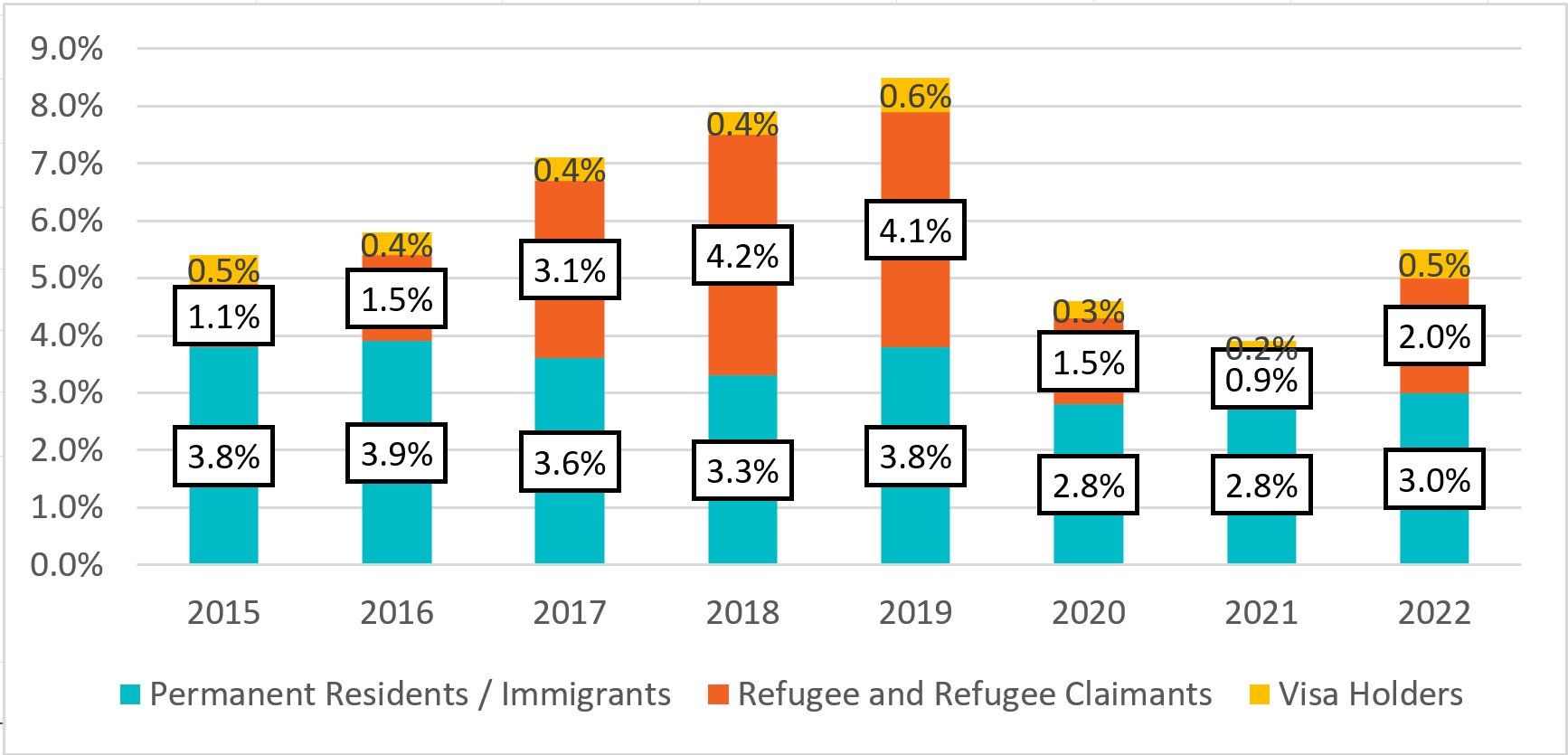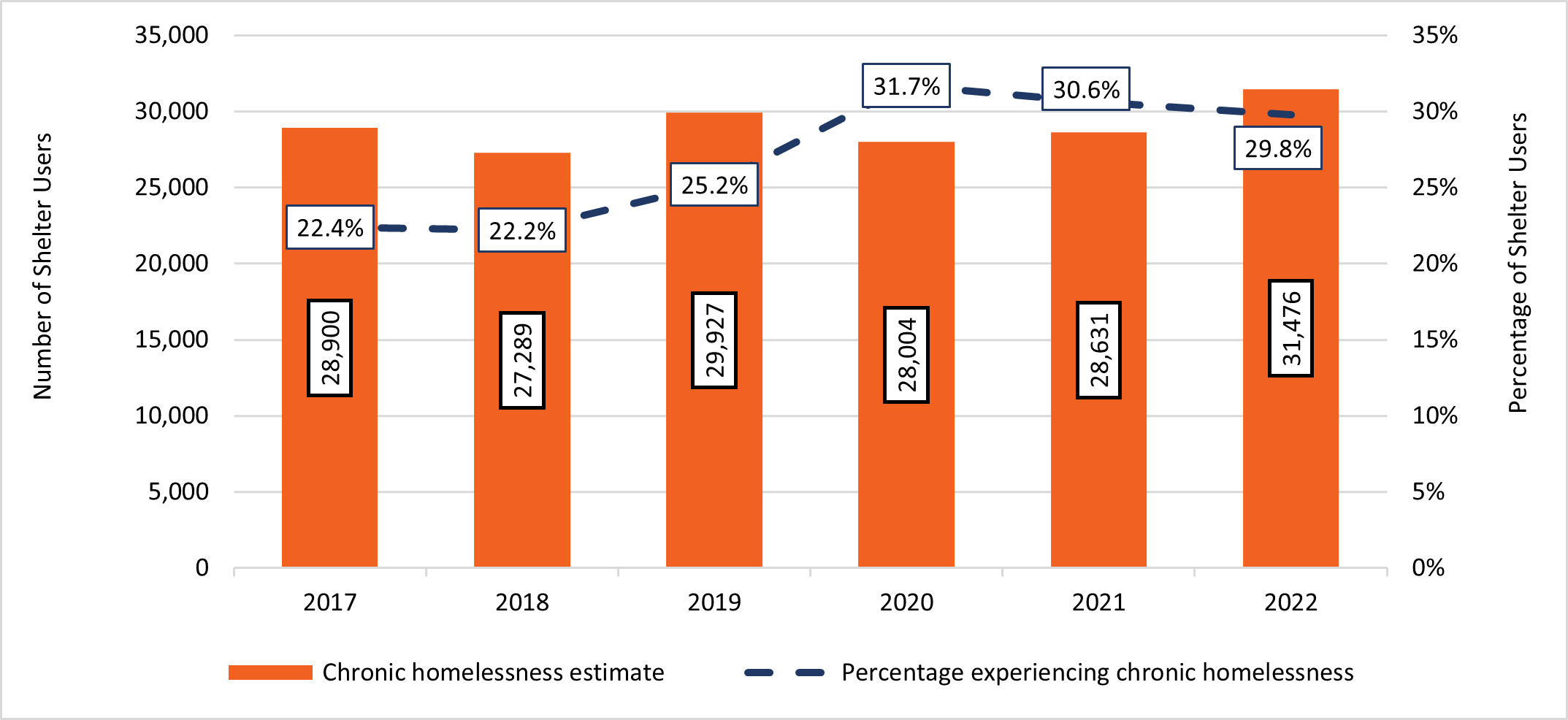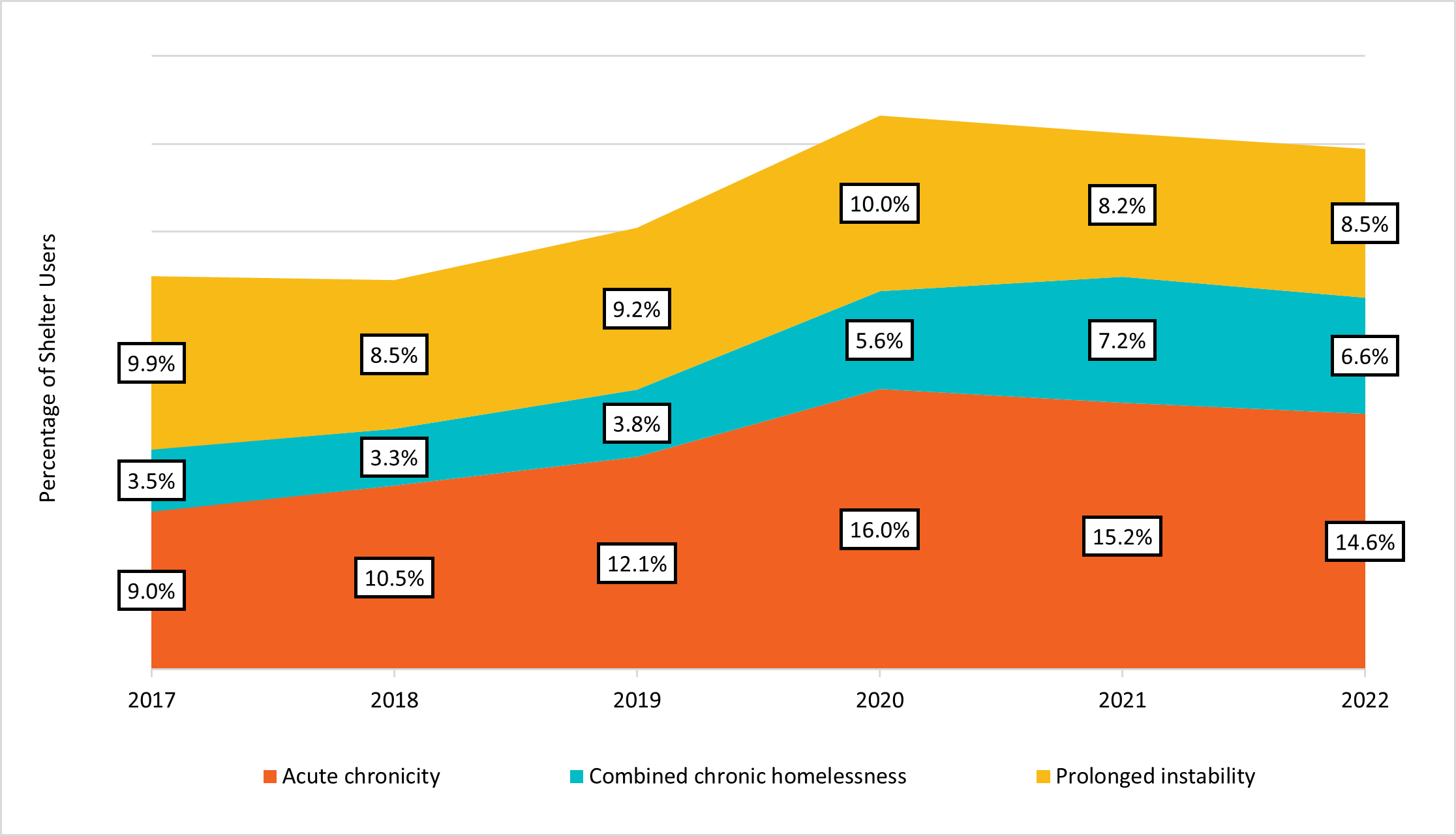Homelessness Data Snapshot: The National Shelter Study 2022 Update
On this page
- Introduction
- Data
- Shelter use in 2022
- Shelter capacity and occupancy
- Demographics
- Chronic homelessness among shelter users
- For more information
Introduction
The National Shelter Study is an ongoing analysis of trends in homelessness shelter use in Canada. The present report provides an update on trends in 2022.
Data
This analysis covers the period from 2005 to 2022 and uses data collected from:
- the Homeless Individuals and Families Information System (HIFIS), and
- provincial and municipal partners that have data sharing agreements with the Government of Canada.
Approximately 50% of emergency shelters in Canada were included in this analysis, representing about 60% of available emergency shelter beds. The methodology takes into account people who use more than one shelter to ensure that individuals are only counted once. Domestic violence shelters, immigrant and refugee shelters, and transitional housing are not included due to insufficient data coverage.
Shelter use in 2022
In 2022, an estimated 105,655 people experienced homelessness in an emergency shelter, compared to 93,529 in 2021 (Figure 1). This increase was expected. As COVID-19 social distancing requirements were lifted, there was a gradual recovery in shelter beds and shelter use. On an average night in 2022, there were approximately 16,248 people staying in shelters, compared to 13,170 in 2021 (23.4% increase).
Figure 1: Number of shelter users from 2005 to 2022

-
Figure 1 - Text version
Figure 1: Number of shelter users from 2005 to 2022 Year
Number of permanent emergency shelter users
2005
156,030
2006
150,663
2007
146,884
2008
151,621
2009
146,726
2010
141,854
2011
137,415
2012
141,405
2013
134,262
2014
136,866
2015
132,511
2016
129,127
2017
129,017
2018
122,914
2019
118,759
2020
88,342
2021
93,529
2022
105,655
Shelter capacity and occupancy
The overall permanent emergency shelter system capacity grew by almost 20% between 2021 and 2022. In 2022 there were 18,336 permanent beds compared to 15,364 beds in 2021 (Figure 2). However, growth was uneven across shelter types. Family shelter capacity increased 33.7%, adult shelter capacity increased 18.0% and while youth shelter capacity increased by 2.9% compared to 2021.
Despite the increase in capacity, shelter occupancy was slightly higher in 2022 (88.6%) compared to 2021 (85.7%), though it did not approach pre-pandemic levels (Figure 2).
Figure 2: Beds available and average occupancy from 2005 to 2022

-
Figure 2 - Text version
Figure 2: Beds available and average occupancy from 2005 to 2022 Year
Average occupancy rate
Beds available
2005
82.7%
15,774
2006
82.0%
15,588
2007
79.1%
15,460
2008
85.7%
15,294
2009
94.6%
15,247
2010
83.2%
14,905
2011
86.3%
14,879
2012
91.9%
14,947
2013
91.2%
14,934
2014
92.4%
14,995
2015
91.2%
15,404
2016
91.0%
15,413
2017
91.7%
15,453
2018
95.2%
15,620
2019
92.3%
15,599
2020
93.7%
12,396
2021
85.7%
15,364
2022
88.6%
18,336
The higher occupancy rate in 2022 was driven by both an increased number of clients and longer shelter stays (Figure 3). In 2015, the average shelter stay among all shelter users was 38.7 days. In 2022, the average stay had climbed to 56.1 days.
Figure 3: Average length of stay per calendar year 2015 to 2022 by shelter type

-
Figure 3 - Text version
Figure 3: Average length of stay per calendar year 2015 to 2022 by shelter type Year
Overall
Youth shelters
Adult shelters
Family shelters
2015
38.7
41.1
37.9
41.9
2016
39.7
41.5
38.6
44.8
2017
40.1
50.0
37.3
51.5
2018
44.2
49.3
42.2
54.2
2019
44.2
43.7
42.4
58.8
2020
48.0
43.2
47.0
58.3
2021
51.4
49.1
48.4
67.1
2022
56.1
56.4
55.2
59.8
Demographics
Age
The average age of shelter users in 2022 was 39.2 years. Accompanied children (aged 0-16) represented 4.2% of shelter users. Youth (aged 13-24) made up 11.4% of shelter users. The majority (60.4%) of shelter users were adults (aged 25-49). Older adults (aged 50-64) were 19.9% of the shelter user population and seniors (aged 65+) were 4.0%. The relative proportions of all age groups have remained relatively unchanged since 2015 with the exception of youth, which has dropped steadily from 17.9% in 2015 to 11.4% in 2022.
Gender
In 2022 66.7% of shelter users were men, 32.2% were women, and 1.1% identified as gender diverse. The proportion of men and women has remained statistically unchanged between 2015 and 2022. A statistically significant increase in the proportion of shelter users reporting as gender diverse was observed between 2015 (0.5%) and 2022 (1.1%).
Indigenous Peoples
Indigenous Peoples continued to be overrepresented in Canada's emergency shelters in 2022. According to the 2021 census, Indigenous Peoples represent about 5.0% of the Canadian population, yet the percentage of shelter users in 2022 who identified as Indigenous was 33.1% (Figure 5). The proportion of Indigenous peoples among shelter users has not changed significantly since 2015 (31.2%).
Figure 4: Proportion of shelter-using population and general population by Indigenous identity (2022)

-
Figure 4 - Text version
Figure 4: Proportion of shelter-using population and general population by Indigenous identity (2022) Population
Non-Indigenous
Indigenous
Shelter users
66.9%
33.1%
General population
95.0%
5.0%
Veterans
An estimated 1.4% of shelter users in 2022 reported serving as either Canadian Armed Forces, former RCMP officers, veterans of allied countries, or civilian veterans. This is consistent with the estimated overall proportion of veterans in Canada (1.7%). The proportion of veterans has not changed significantly since 2015 (1.9%).
Citizenship
In 2022, the majority (90.3%) of shelter users were Canadian citizens, which has been the case for all years of analysis since 2015. The proportion of refugees and refugee claimants in the shelter system was 2.0% in 2022, up from 2021 (0.9%) but down compared to pre-pandemic (2019, 4.1%). Pandemic travel restrictions in 2020 and 2021 may have contributed to a decrease in the number of asylum claims, with a partial recovery in 2022.
Figure 5: Proportion of non-citizens among shelter using population from 2015 to 2022

-
Figure 5 - Text version
Figure 5: Proportion of non-citizens among shelter using population from 2015 to 2022 Year
Permanent Residents / Immigrants
Refugee and Refugee Claimants
Visa Holders
2015
3.8%
1.1%
0.5%
2016
3.9%
1.5%
0.4%
2017
3.6%
3.1%
0.4%
2018
3.3%
4.2%
0.4%
2019
3.8%
4.1%
0.6%
2020
2.8%
1.5%
0.3%
2021
2.8%
0.9%
0.2%
2022
3.0%
2.0%
0.5%
Chronic homelessness among shelter users
In 2022, data from a subset of 17 communities were used to estimate chronic homelessness in CanadaFootnote 1. Shelter users are considered chronically homeless if they meet at least one of the following criteria:
- Acute chronicity: used a shelter for six months (180 days) or more in the past year
- Prolonged instability: had shelter stays in each of the last three years
In 2022, 29.8% of shelter users in the sample met one or both of the criteria for chronic homelessness (down from 30.6% in 2021). By applying this proportion to the national estimate of shelter users, an estimated 31,476 shelter users experienced chronic homelessness in 2022, representing an increase of 9.9% from 2021 (28,631) (see Figure 6).
Figure 6: Proportion and estimated number of chronic shelter users from 2017 to 2022

-
Figure 6 - Text version
Figure 6: Proportion and estimated number of chronic shelter users from 2017 to 2022 Year
Percentage experiencing chronic homelessness
Chronic homelessness estimate
2017
22.4%
28,900
2018
22.2%
27,289
2019
25.2%
29,927
2020
31.7%
28,004
2021
30.6%
28,631
2022
29.8%
31,476
Looking more specifically at shelter users who met each criterion of chronic homelessness, 14.6% of shelter users met the criteria for acute chronicity only, 8.5% for prolonged instability only, and 6.6% met the criteria for both types of chronic homelessness (Figure 7).
From 2017 to 2020, there was an increase in the proportion of shelter users who met only the acute chronicity indicator (from 9.0% to 16.0%), but has since fallen slightly in 2022 to 14.6%. The proportion who experienced prolonged instability has fluctuated over time (between 8.2% and 10.0%). The proportion of shelter users who experienced both types of chronic homelessness was stable between 2017 and 2019 (from 3.5% to 3.8%), yet this proportion has since increased, resting at 6.6% in 2022.
Figure 7. Acute chronicity and prolonged instability from 2017 to 2022

-
Figure 7 - Text version
Figure 7. Acute chronicity and prolonged instability from 2017 to 2022 Year
Acute chronicity
Combined chronic homelessness
Prolonged instability
Total chronic homelessnessFootnote 2
2017
9.0%
3.5%
9.9%
22.4%
2018
10.5%
3.3%
8.5%
22.2%
2019
12.1%
3.8%
9.2%
25.2%
2020
16.0%
5.6%
10.0%
31.7%
2021
15.2%
7.2%
8.2%
30.6%
2022
14.6%
6.6%
8.5%
29.8%
For more information
To find out more about homelessness research, visit the Data analysis, reports and publications page.
If you have any questions about this report, contact us.
-
Copyright
© 2024 HIS MAJESTY THE KING IN RIGHT OF CANADA as represented by the Minister of Housing, Infrastructure and Communities.
Catalogue No. T94-60/2024E-PDF
ISBN 978-0-660-70302-2
Report a problem on this page
- Date modified:
